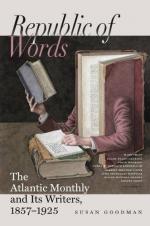The next spread was spun and woven by Mrs. Katy’s beloved Aunt Eunice,—a mythical personage, of whom Mary gathered vague accounts that she was disappointed in love, and that this very article was part of a bridal outfit, prepared in vain, against the return of one from sea, who never came back,—and she heard of how she sat wearily and patiently at her work, this poor Aunt Eunice, month after month, starting every time she heard the gate shut, every time she heard the tramp of a horse’s hoof, every time she heard the news of a sail in sight,—her color, meanwhile, fading and fading as life and hope bled away at an inward wound,—till at last she found comfort and reunion beyond the veil.
Next to this was a bed-quilt pieced in tiny blocks, none of them bigger than a sixpence, containing, as Mrs. Katy said, pieces of the gowns of all her grandmothers, aunts, cousins, and female relatives for years back,—and mated to it was one of the blankets which had served Mrs. Scudder’s uncle in his bivouac at Valley Forge, when the American soldiers went on the snows with bleeding feet, and had scarce anything for daily bread except a morning message of patriotism and hope from George Washington.
Such were the memories woven into the tapestry of our little boudoir. Within, fronting the window, stands the large spinning-wheel, one end adorned with a snowy pile of fleecy rolls,—and beside it, a reel and a basket of skeins of yarn,—and open, with its face down on the beam of the wheel, lay always a book, with which the intervals of work were beguiled.
The dusky picture of which we have spoken hung against the rough wall in one place, and in another appeared an old engraved head of one of the Madonnas of Leonardo da Vinci, a picture which to Mary had a mysterious interest, from the fact of its having been cast on shore after a furious storm, and found like a waif lying in the sea-weed; and Mrs. Marvyn, who had deciphered the signature, had not ceased exploring till she found for her, in an Encyclopaedia, a life of that wonderful man, whose greatness enlarges our ideas of what is possible to humanity,—and Mary, pondering thereon, felt the Sea-worn picture as a constant vague inspiration.
Here our heroine spun for hours and hours,—with intervals, when, crouched on a low seat in the window, she pored over her book, and then, returning again to her work, thought of what she had read to the lulling burr of the sounding wheel.
By chance a robin had built its nest so that from her retreat she could see the five little blue eggs, whenever the patient brooding mother left them for a moment uncovered. And sometimes, as she sat in dreamy reverie, resting her small, round arms on the window-sill, she fancied that the little feathered watcher gave her familiar nods and winks of a confidential nature,—cocking the small head first to one side and then to the other, to get a better view of her gentle human neighbor.




